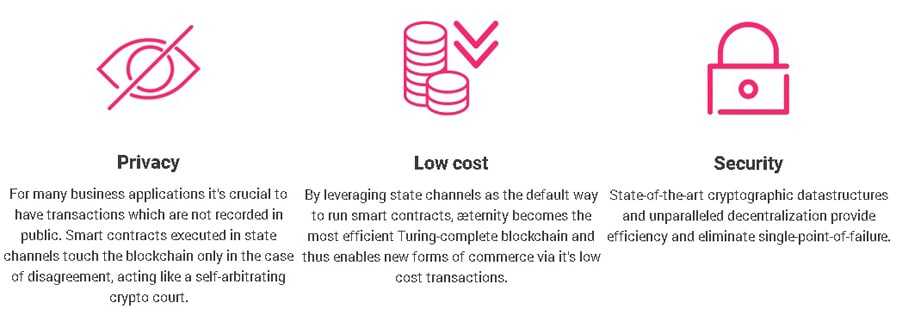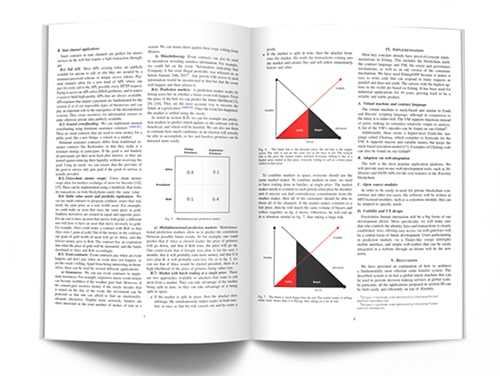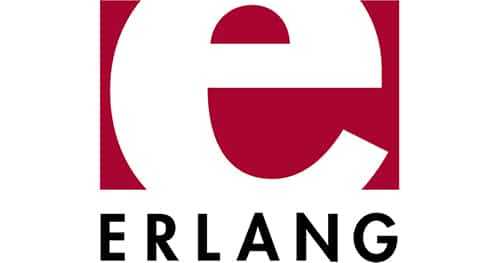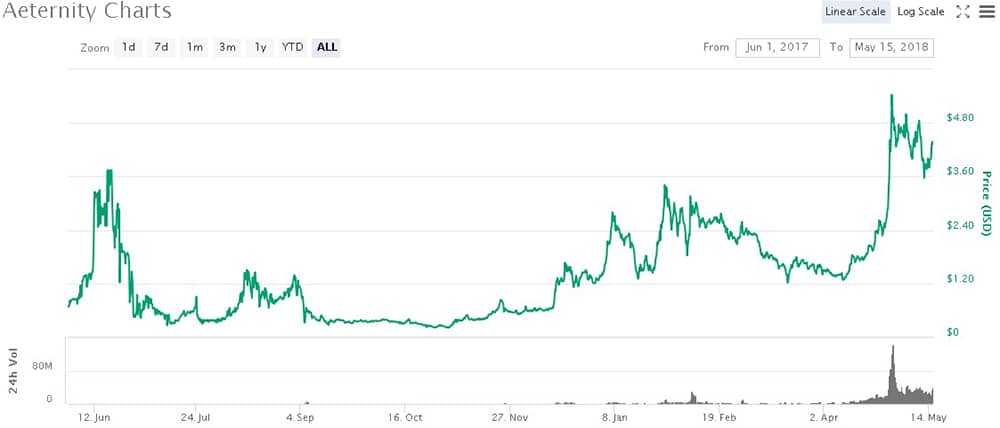Aeternity (AE) Review: Building Scalable Smart Contracts
Aeternity claims that they are developing a brand new and revoltutionary blockchain technology.
This claim has been made quite a bit recently as numerous cryptocurrency projects from Cardano to EOS and NEO have envisioned a completely new blockchain. Many people are also wondering if there is even space for another form of "blockchain technology".
Yet, the Aeternity blockchain is quite unique and has several features that separate it from others. They also have a number of innovative solutions to problems there are currently plaguing a number of established blockchains.
In this comprehensive review, we will take a look at the underlying Aeternity technology and why it could transform the way we think about blockchains. We will delve into the team, roadmap, pros / cons and token potential.
With that being said, let's jump right in.
What is Aeternity?
Aeternity is a blockchain project that wants to create an ecosystem that has transparent governance with efficiency and global scalability for smart contracts and decentralised applications (dApps).
The company completed a successful crowd sale and ICO in 2017 of their AE tokens. They managed to raise a total of $24m when the ICO was completed in June of last year. Towards the end of last year they launched on testnet.

The main problem that Aeternity is trying to solve is the question around smart contract scalability. This is particularly relevant currently given the bottlenecks that we have experienced last year for more established smart contract tokens such as Ethereum.
In fact, the Ethereum developers have even acknowledged this themselves as they have claimed that the scaling problem is "perhaps the single most important key technical challenge" that blockchains are facing.
Aeternity aims to solve this by combining 4 powerful pieces of technology. These are the following:
- State Channels
- Consensus
- Unique Governance
- Blockchain Oracles
Some of these terms may seem familiar to you while others are slightly more complicated. We will take a look at each in a bit more depth.
State Channels
These are where the smart contracts will exist off the main blockchain. The only time that these state channels will communicate with the Aeternity blockchain is in settlement or in the case of any sort of disagreement between the smart contract participants.
Why are these relevant?
They mean that people and businesses can interact with each other in a private manner. There is no need to let a public blockchain know about the contract. This is important for business contracts where data and terms are better kept private.
If there are any disagreements and the contracting parties need to consult the Aeternity blockchain for adjudication, zero knowledge proofs are used to keep them private. Moreover, given that the blockchain protocol acts in a predictable way, there is no incentive for any contracting party to break their side of the agreement.
Apart from being private, these smart contract settlements are extremely fast. This is because they are executed off chain and these state channels will not be slowed down due to other contracts that are being executed.
In essence, with state channels we have fast and private smart contracts.
Unique Consensus
The Aeternity blockchain makes use of a hybrid of Proof of Work (PoW) and Proof of Stake (PoS) consensus algorithms.
More specifically, the miners will mine blocks and verify transactions in a manner similar to Ethereum and Bitcoin. However, Aeternity has built in a slight variation called the "Cuckoo cycle" which is a new graph-theoretic PoW algorithm.
This combines scalable memory requirements with instant verifiability. This will incentivise devices with dynamic ram such as mobile devices. This means that participants do not need powerful mining rigs to take part in the Aeternity mining process.
Then, when it comes to governance and development decisions, Aeternity will use a delegated proof of stake (dPoS) voting mechanism. The votes will be weighted according to how much AE tokens the participants hold.
Governance Structure
The governance structure that underlines Aeternity is unique in that is gives all participants the tools to govern themselves. This ties in with the delegated voting at the protocol level.
However, Aeternity has built in functionality to deal with the non-technical nature of human interaction any disagreements. Governance is often a human problem that cannot be solved by a protocol but by compromise.
The Aeternity technology allows for the delegated proof of stake voting to take place but also has the frameworks in place for human interaction and constructive discussion.
Oracles
These are probably one of the most important parts of the Aeternity blockchain. We have previously covered oracles but oracles essentially connect the blockchain to real world data. This is because numerous smart contracts are contingent on external data.
In the Aeternity ecosystem, these decentralised Oracles will provide tamperproof data that will then be used in the calculations of the smart contracts. Oracles are useful for events such as prediction markets, betting and other defined outcomes.
For example, if there is a smart contract that will pay out one party based on the results of a soccer match, then the Oracle will be providing the data about said match. It will be collecting the score and feeding that information into the smart contract.
Moreover, with Aeternity, there is a further layer of security with the oracles. Due to the fact that an Oracle's data could be tampered with while off-chain, Aeternity implements a separate predication market where the participants can bet on the accuracy of the data coming in from the Oracle.
Developing Aeternity Smart Contracts

Aeternity allows the participants to code functional smart contracts. The smart contract participants are also responsible for maintaining their own state as it does not support stateful programming. The participants would confirm the state as inputs to the smart contract.
This is a sharp departure from other smart contract blockchains. For example, Ethereum is of the view that stateful programming is essential for any sort of decentralised applications. This is quite a dilemna as functional programs are easier to scale.
Many other blockchains are trying to balance these separate demands. Etheruem is trying to come up with an effective alternative between the two in the form of "state sharding". This will all form part of the latest updates that are taking place in the Ethereum Metropolis upgrade.
The smart contract language that Aeternity uses is Chalang which is a higher level forth like language. It will compile into bytecode for use in the Aeternity Virtual Machine. They hope to release a more developer friendly version in the future that could include JavaScript Libraries.
Aeternity "Aepps"
Aepps are the name given to the dApps on the Aeternity platform. There are already several of these that are under development by the team in order to demonstrate their functionality. They hope to release this before the launch of the mainnet.
These dApps will be focused on mobile use and user experience. They hope to also attract external developers for mobile applications by making the tools workable with frameworks such as React. They also want to build an incubator which will help by providing support for projects on Aeternity.
Other Features

There are a few other notable features of Aeternity that make the technology much more robust. This includes the industrial level blockchain code. The core blockchain is coded in Erlang which makes it easy to write fault tolerant and distributed code.
Aeternity also features a user friendly Domain Name System (DNS) that is decentralised and secure. This could make it easier for people to read particular addresses and reduce the impact of phishing attempts as incorrect addresses can be easily spotted.
Another interesting feature that is included in the Aeternity blockchain is the possibility to create your own identity and use it online. Identity management is something that other blockchain projects such as Civic are trying to implement.
Aeternity Use Cases
There are a number of use cases for the Aeternity blockchain. As mentioned above, the privacy and scalability provided by the state channels are ideal for many businesses and organisations.
For example, they could be used in crowdfunding projects. The participants could use dominant assurance contracts. These are smart contracts that can be used to raise money while protecting the investors against any failures to launch etc.
The Aeternity ecosystem can also be used for decentralised financial technology. There are a number of transactions that are contingent on particular conditions being met. Traditionally, escrow services have being used. Now, a simple state contract can be used instead.
Or how about the possibility of a digital asset exchange?
Through the use of trusted cross chain atomic swaps, Aeternity's ecosystem can be used to exchange two cryptocurrencies. This could also limit the need for large centralised exchanges which are often seen as a single point of failure.
Aeon Token
The Aeternity token (AE) was launched in 2017 and was initially traded as an ERC20 standard token. This is because it was still in testnet phase. When the token launches it will be switched to the Aeternity native tokens.
The Aeon will be the utility token for the smart contracts. All of the contracts will settle in Aeon and they will also be used to pay for transaction fees on the network. Hence, they operate much like ETH in the Ethereum ecosystem.
The token is currently sitting at 27 in market cap rank. AE has gone through a few periods of intense interest that has been followed by stagnating demand. However, as we move closer to the launch of the mainnet we have seen a rally in the price recently.

There are a number of exchanges where you can buy AE tokens. These include Bittrex.com, Binance.com and HitBtc. Once you have your AE token, given that it is an ERC20 standard, you can store it in any Ethereum wallet. Of course, they will announce measures you should take when they move away from the ERC20 standard.
Aeternity Team Members
There are some really powerful names behind Aeternity. In the pilot seat, we have Yanislav Malahov. He was one of the first people to have envisioned blockchain algorithms back in 2013. He has also being called the "Godfather of Ethereum" as it was these ideas that gave impetus to the project.
The COO is Emin Mahrt who has helped found a number of startups including Dropshot and Abend. He is also an early adopter within the blockchain space. For example, he is an ex Bitcoin miner as well as one of the early investors in Ethereum.

There is also extensive experience in the developer pool at Aeternity. For example, there are 6 PhDs on the team who have backgrounds ranging from distributed systems to data science and security. There are also numerous Erlang developers who are lending their weight to the program.
This is no doubt one of the most advanced development teams on paper and it seems that as Aeternity approaches the mainnet, we are likely to see many more joining.
Aeternity Roadmap
Aeternity is quite far along on their development roadmap. They have launched on their testnet and completed the backing campaign as well as started development of several essential applications.
Prior versions of their roadmap had them completing their security audit by Q1 2018, but this seems to have been pushed back to Q2. The much more important next step will be the release of the mainnet in Q2 as well.
One thing that we did find refreshing was the continually updated Aeternity blog pages. All development updates are being well communicated to the community through a number of different channels. You can track the work being completed on by the developers by taking a gander at the project's Github.
Potential Competition

While the Aeternity blockchain is indeed one of the most promising, there is a great deal of competition that they face in they face from other smart contract blockchains and ecosystems. Some have already being released and others are imminent.
For example, another smart contract ecosystem that has been performing quite well recently is that of the Neo smart economy. This blockchain also makes use of similar technology such as Delegated Byzantine Fault Tolerance (DBFT). The project already has a number of dApps that have been built on top of it.
You also have a strong alternative in the form of EOS. EOS has been getting a great deal of attention recently and the rally in the price seems to reflect that. Like Aeternity, EOS is concerned with blockchain scalability and have implemented a delegated proof of stake consensus algorithm.
Another really interesting blockchain project that is garnering a great deal of attention is Zilliqa (ZIL). This project is also focused on smart contract scaling and is in fact the first blockchain project to implement a sharding solution.
Lastly, Ethereum is not going anywhere and the original smart contract blockchain is implementing a number of upgrades to the network that will help with scaling and supercharge adoption. These include moving to a Proof of Stake consensus algorithm called Casper as well as blockchain sharding.
The Ethereum developers are testing the sharding solution on the Ethereum testnet and have released the code for their hybrid PoS consensus algorithm. If all goes to plan, they hope to release this hybrid version onto the mainnet in the next few months.
Should You Consider Aeternity?
The Aeternity project is no doubt quite an ambitious one. The project aims to solve some of the most important issues that are plaguing blockchain technology currently.
Having state channel smart contracts and decentralised oracles means that numerous enterprises can enter contracts without worry of bottlenecks and privacy.
They also seem to be moving ahead at a steady pace as the regular updates and commits can lay testament to. One can also appreciate the highly skilled team members that are forging ahead on the Aeternity project. It seems to be one of the most qualified blockchain project teams.
Yet, it would be naive to assume that Aeternity will be the smart contract blockchain to challenge Ethereum dominance. From NEO to EOS and Zilliqa, there are a number of ambitious projects that are making strides in blockchain scaling.
So, should you invest in AE Tokens?
We cannot give investing advice at the Bureau, but a "smart contract" portfolio that includes a healthy balance of AE with the strongest competing tokens could be worth considering.
Disclaimer: These are the writer’s opinions and should not be considered investment advice. Readers should do their own research.
